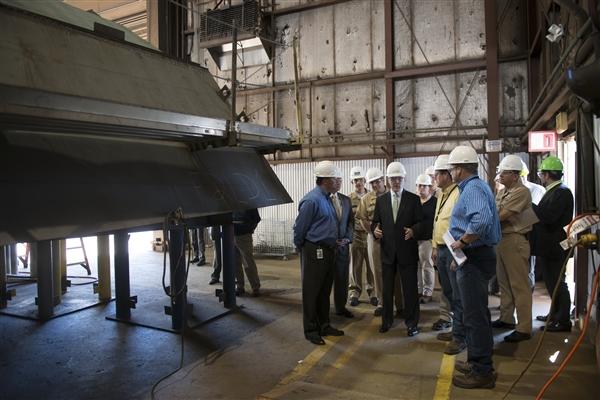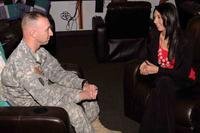WASHINGTON -- A Defense Department initiative is helping service members who plan to leave the military acquire civilian credentials for technical professions so they can move more quickly into the private sector, the department's director of force readiness and training said in a recent DoD News interview.
Frank DiGiovanni said the initiative was helped along substantially by a change Congress made in 2012 in a section of Title 10 of the U.S. Code.
Title 10 outlines the role of the military in the U.S. Code, and in the change, Congress gave DoD the authority to let separating service members have job-skills training programs, internships or apprenticeships as part of their duty assignments.
"It's a pretty significant change in Defense Department authorities, and meant to assist in transition," DiGiovanni said. "It's not only for career fields the service members are in, but for any kind of training. Several programs now are leveraging that new authority."
Credentialing in Multiple Professions
DoD and the services have implemented pilot credentialing programs in seven major professions: truck driving, medical, supply, automotive mechanics, aircraft mechanics, information technology and manufacturing.
Whether military training exactly matches the skill levels needed for civilian licensing or certification depends on the career field, DiGiovanni said.
"There are many military career fields where, with just a little bit of gap training, you can step right into a civilian job," he said, adding that an Army or a Marine Corps allied trade specialist career is one of these.
"At Fort Lee [in Virginia], right after you graduate the Allied Trade Specialist Program -- they were third-party certified by the American Welding Society -- an instructor could take you out, you'd do your weld, and if you passed, you'd get American Welding Society certification," DiGiovanni said. "That's one example where there isn't much difference between the training they did in the military and what a service member would need to be successful on the outside."
In other professions, service members would need what DiGiovanni calls "gap training."
"In truck driving, for example, ... there are a couple of major differences," he explained. "Most [military] trucks are automatic, and most of the large [commercial] trucks and trailers on the road are manual transmissions. Most of our trucks don't have air brakes, and most of the large tractor-trailers do."
The director said DoD focuses its credentialing efforts along three lines across a service member's career:
- At the beginning, when they complete initial occupational training;
- Mid-career, when credentialing often requires time in the field or higher skill levels in addition to technical training; and
- End of career, as a service member plans their transition into civilian life.
Working with Private Sector
DiGiovanni said DoD has taken unique approaches to working with the private sector to find credentialing opportunities for service members. In the manufacturing sector, he said, DoD has worked closely with several accrediting bodies, mostly focusing on logistics.
"We've also worked with the American Welding Society; we work with CompTIA, a certifying agency for information technologies; we work with the American National Standards Institute -- ANSI; we work with the American Society of Engineers; and we work with an automotive organization," the director said.
DoD works with the power industry for credentialing and licensing, and at Fort Stewart in Georgia, 10 service members graduated recently from a free three-week training session provided by Georgia Power, DiGiovanni said.
"And those folks are going to step right into jobs in the power industry," he said.
Others who have done free training of service members include General Motors, the Teamsters and the United Association's Veterans in Piping program. The United Association's full name is the United Association of Journeymen and Apprentices of the Plumbing and Pipe Fitting Industry of the United States, Canada and Australia.
Getting the Word Out
To promote the credentialing initiative, DoD has done what DiGiovanni calls a "cold rollout" of a mobile application known as the DoD SkillBridge, available online at http://www.dodskillbridge.com.
The app uses a Twitter-like, 140-character tweet and hashtags, SMS texts and emails to alert users to new jobs and training opportunities. And potential users can follow @DoD_SkillBridge on Twitter.
DoD's SkillBridge allows the industry to post job-skills training opportunities categorized by hashtag, DiGiovanni said. "So if you're interested in jobs in welding," he added, "you say, 'I want tweets when there's a new job or training available in #welding or #heavyconstruction.' And you can say what geographic area you're interested in."
Even the SkillBridge Twitter feed offers opportunities to #TrainInEscondido or #TrainInJohnstown.
"We think this connection tool will help get the program out there and get it more recognized and understood," the director said. "It's also being incorporated into the Transition Assistance Program," established to help separating service members transition into civilian life by offering job-search assistance and related services.
On the front end, DiGiovanni said, "we're asking the services to talk to their service members about licensing and credentialing opportunities. There's benefit for the service member and for the force to broaden their foundational understanding of the occupational area they're in. We are looking at institutionalizing this across the entire continuum of military service."
Balancing Career Opportunities
The director characterized the initiative as a way to balance opportunities long offered to service members in higher education with other kinds of educational options.
"Not everyone wants a four-year degree," DiGiovanni said, adding that the careers in which training is offered -- health care and medical, information technology and cyber security, logistics, manufacturing and others -- require people who have high degrees of technical competence.
"I think this program is going to take us to new ground," DiGiovanni said. "It's focused. There's an authority now that wasn't there before. And last year, 298,000 people got out of the military. The average number is around 250,000. So this is an enduring issue, and this new authority and new emphasis certainly helps our service members transition back to civilian life."
Want to Know More About the Military?
Be sure to get the latest news about the U.S. military, as well as critical info about how to join and all the benefits of service. Subscribe to Military.com and receive customized updates delivered straight to your inbox.











